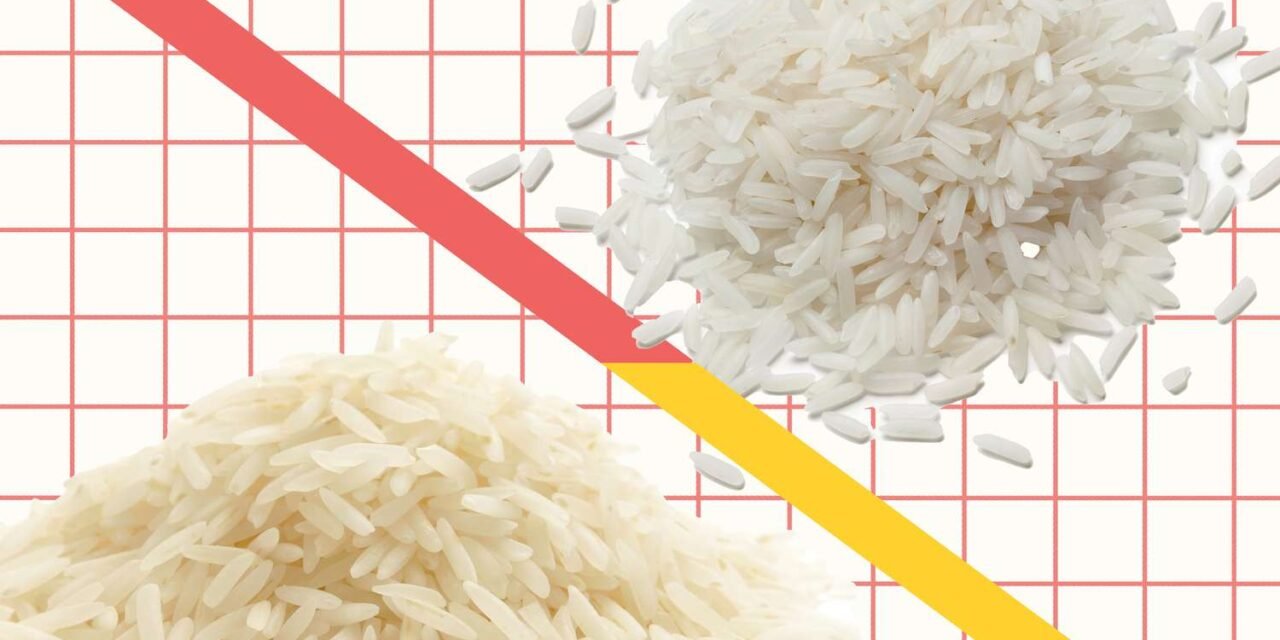Basmati rice is a unique variety of aromatic rice known for its distinct characteristics, which set it apart from other aromatic rice varieties. Its origins, grain structure, cooking properties, aroma, and flavor profile make it a premium choice in global cuisines. Here’s a detailed comparison of Basmati rice with other aromatic rice varieties:
1. Origin and Geographical Indication
- Basmati Rice:
- It originates from the Indian subcontinent and is primarily grown in India and Pakistan.
- Protected under Geographical Indication (GI) status, with specific regions like the Himalayan foothills designated for authentic Basmati production.
- Other Aromatic Rice Varieties:
- Varieties like Jasmine rice come from Southeast Asia, particularly Thailand, Vietnam, and Cambodia.
- U.S.-grown aromatic rice varieties, such as Texmati and Calrose, are developed as hybrids.
2. Grain Length and Shape
- Basmati Rice:
- Long-grain rice with slender, needle-like grains.
- Known for its elongation during cooking, with grains expanding up to twice their raw length.
- Other Aromatic Rice Varieties:
- Jasmine Rice: Medium-to-long grains that are broader and thicker than Basmati.
- Khao Dawk Mali (Thai Jasmine): Slightly shorter grains compared to Basmati.
- Kalijira (Bangladeshi Aromatic): Small and thin grains, often called “baby Basmati.”
3. Aroma and Flavor
- Basmati Rice:
- Has a distinct nutty, floral aroma attributed to a compound called 2-acetyl-1-pyrroline.
- Offers a delicate, slightly nutty flavor, ideal for biryanis, pilafs, and festive dishes.
- Other Aromatic Rice Varieties:
- Jasmine Rice: Sweet and floral aroma with a buttery taste, often used in Southeast Asian cuisines.
- Wehani and Red Rice: Earthy and nutty flavor with a robust aroma.
- Kalijira: Milder aroma compared to Basmati, with a slightly sweet taste.
4. Cooking Properties
- Basmati Rice:
- Cooks to a firm, separate, and non-sticky texture.
- Retains its structure and doesn’t clump together, making it suitable for dishes where individual grains are desired.
- Other Aromatic Rice Varieties:
- Jasmine Rice: Tends to clump slightly when cooked due to higher starch content, resulting in a soft and sticky texture.
- Glutinous Rice (Sticky Rice): Extremely sticky when cooked, often used in desserts or specific Asian dishes.
- Kalijira: Similar to Jasmine rice in clumping tendency but with a softer texture.
5. Nutritional Profile
- Basmati Rice:
- Slightly lower glycemic index (GI) compared to other rice varieties, making it a preferred choice for diabetics.
- Provides moderate amounts of calories, carbohydrates, and essential nutrients like niacin and magnesium.
- Other Aromatic Rice Varieties:
- Jasmine Rice: Typically higher GI due to its softer starch structure.
- Brown Aromatic Rices (e.g., Brown Basmati, Red Jasmine): Higher fiber and nutrient content due to the presence of bran layers.
6. Water Absorption and Cooking Ratios
- Basmati Rice:
- Requires less water for cooking, typically a 1:1.5 or 1:2 ratio (rice to water).
- Benefits from soaking prior to cooking to enhance grain elongation.
- Other Aromatic Rice Varieties:
- Jasmine Rice: Requires a 1:2 or higher ratio of rice to water for a softer texture.
- Sticky Rice: Often steamed rather than boiled, with grains pre-soaked for hours.
7. Culinary Applications
- Basmati Rice:
- Favored for Indian, Pakistani, and Middle Eastern dishes like biryanis, pilafs, pulaos, and side dishes for curries.
- Often used in celebratory and festive meals due to its premium quality and aroma.
- Other Aromatic Rice Varieties:
- Jasmine Rice: A staple in Southeast Asian cuisines, complementing stir-fries, curries, and grilled meats.
- Glutinous Rice: Used in Asian desserts (e.g., mango sticky rice) and dim sum.
- Kalijira: Often prepared as soft, porridge-like dishes in Bangladeshi cuisine.
8. Price and Availability
- Basmati Rice:
- Typically more expensive due to its GI certification, aging process, and export demand.
- Requires careful sourcing to ensure authenticity.
- Other Aromatic Rice Varieties:
- Jasmine Rice: More widely available and generally less expensive than Basmati.
- Kalijira and Specialty Rices: Limited to niche markets and may be harder to find outside their native regions.
9. Aging Process
- Basmati Rice:
- Often aged for up to 12–18 months to intensify its aroma and improve cooking qualities.
- Aging enhances the firmness and elongation of grains during cooking.
- Other Aromatic Rice Varieties:
- Typically consumed fresh or after minimal aging (e.g., Jasmine rice is usually not aged).
10. Sustainability and Farming Practices
- Basmati Rice:
- Cultivated in specific ecological conditions, such as the Himalayan foothills.
- Requires careful irrigation and long growth cycles, leading to higher water use.
- Other Aromatic Rice Varieties:
- Jasmine Rice: Often cultivated in rain-fed fields in Southeast Asia, with lower water dependency than Basmati.
- Indigenous Aromatic Rice: Many are grown in traditional, organic, or sustainable farming systems, adding to their appeal in niche markets.
Conclusion
Basmati rice stands out from other aromatic rice varieties due to its geographical origins, long-grain structure, nutty aroma, and firm texture after cooking. While other aromatic varieties like Jasmine rice are prized for their softness and floral notes, Basmati’s unique combination of characteristics makes it a favorite for specific culinary traditions, particularly in Indian, Pakistani, and Middle Eastern cuisines. Each variety has its strengths, tailored to regional dishes and consumer preferences, contributing to their global appeal.
Hashtags
#RiceRecipes #HealthyEating #FoodieFaves #RiceDishes #CookingWithRice #RiceCookingTips #RiceNutrition #RiceBenefits #RiceFacts #RiceHistory #RiceCulture #RiceTraditions #RiceHarvest #RiceFields #RiceFarming #RiceProduction #RiceExports #RiceImportance #RiceVariety #RiceGrains









